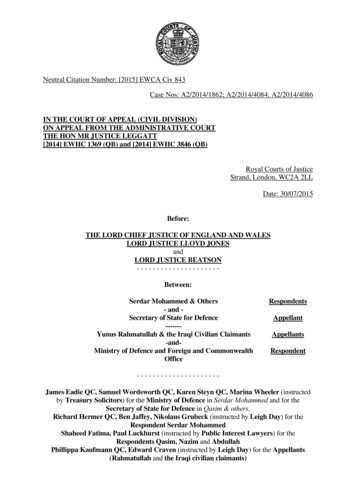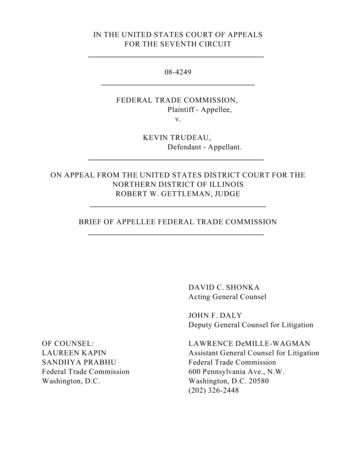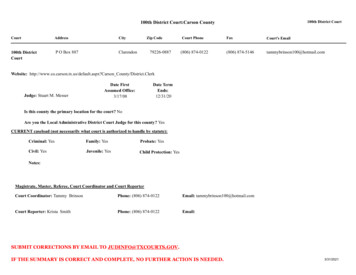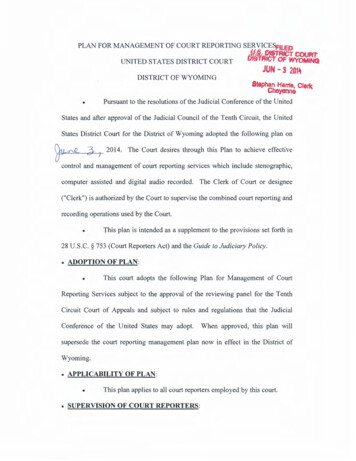
Transcription
Neutral Citation Number: [2015] EWCA Civ 843Case Nos: A2/2014/1862; A2/2014/4084; A2/2014/4086IN THE COURT OF APPEAL (CIVIL DIVISION)ON APPEAL FROM THE ADMINISTRATIVE COURTTHE HON MR JUSTICE LEGGATT[2014] EWHC 1369 (QB) and [2014] EWHC 3846 (QB)Royal Courts of JusticeStrand, London, WC2A 2LLDate: 30/07/2015Before:THE LORD CHIEF JUSTICE OF ENGLAND AND WALESLORD JUSTICE LLOYD JONESandLORD JUSTICE BEATSON--------------------Between:Serdar Mohammed & Others- and Secretary of State for Defence------Yunus Rahmatullah & the Iraqi Civilian Claimants-andMinistry of Defence and Foreign and spondent--------------------James Eadie QC, Samuel Wordsworth QC, Karen Steyn QC, Marina Wheeler (instructedby Treasury Solicitors) for the Ministry of Defence in Serdar Mohammed and for theSecretary of State for Defence in Qasim & others.Richard Hermer QC, Ben Jaffey, Nikolaus Grubeck (instructed by Leigh Day) for theRespondent Serdar MohammedShaheed Fatima, Paul Luckhurst (instructed by Public Interest Lawyers) for theRespondents Qasim, Nazim and AbdullahPhillippa Kaufmann QC, Edward Craven (instructed by Leigh Day) for the Appellants(Rahmatullah and the Iraqi civilian claimants)
Judgment Approved by the court for handing down(subject to editorial corrections)Serdar MohammedJames Eadie QC, Karen Steyn QC, Ben Watson, Melanie Cumberland (instructed byTreasury Solicitors) for the Respondents in Rahmatullah (Ministry of Defence and Foreignand Commonwealth Office)Derek Sweeting QC, James Purnell (instructed by Treasury Solicitors) for the Respondentin the Iraqi civilian claimants’ case (Ministry of Defence)Hearing dates: 9 - 13 February 2015Further Submissions: 18 and 20 February;2, 19, 20 and 31 March; 9, 22 and 30 Apriland 5 May 2015.---------------------Judgment Approved by the courtfor handing down(subject to editorial corrections)If this Judgment has been emailed to you it is to be treated as ‘read-only’.You should send any suggested amendments as a separate Word document.ITHE ISSUES AND SUMMARY(1) The main appeal(a) The central issue(b) The two bases of SM’s claim(c) The position of the Secretary of State(d) Summary of our conclusions in relation to the main appeal(2) The conjoined appeals(a) The PIL claimants(b) The claim by Yunus Rahmatullah, Anamatullah Ali and the Iraqicivilian claimants(c) The issue on act of state in the claim by Yunus Rahmatullah andthe Iraqi civilian claimants(d) Our conclusion(3) The organisation of the judgmentII THE FACTS, FACTUAL ASSUMPTIONS AND LEGALASSUMPTIONS(1) The facts in relation to SM’s claim(a) The original involvement of HM armed forces in Afghanistan(b) The Bonn Agreement(c) UN Security Council Resolution 1386 of 2001; theestablishment of ISAF(d) The Military Technical Agreement of January 2002(e) The command of ISAF(f) The Memorandum of Understanding between the UnitedKingdom and Afghan Government made in 2006(2) The factual assumptions as to the detention of SM(3) The legal assumptions as to SM’s claimPara no11156811121723272829292931343637414344
Judgment Approved by the court for handing down(subject to editorial c)The factual assumptions as to the claims by YunusRahmatullah and the Iraqi civilian claimantsTHE LIABILITY OF THE SECRETARY OF STATE ONBEHALF OF THE UNITED KINGDOM AND THEAVAILABILITY OF UNITED NATIONS IMMUNITYATTRIBUTION TO ISAF/UNThe facts in relation to the control over SM’s detentionThe applicable legal principles: Behrami/Saramati and AlJeddaThe judge’s decisionDid the UN Security Council exercise the requisite control overISAF?Did ISAF authorise SM’s detention?Did ISAF consent by acquiescence to the United Kingdom’sdetention practice?CAN THE SECRETARY OF STATE INVOKE THEIMMUNITIES OF THE UN?THE PUBLIC LAW CLAIM: THE SCOPE OF THEECHR AND ITS RELATIONSHIP TO INTERNATIONALHUMANITARIAN LAWTHE SCOPE OF THE ECHR AS APPLIED TO HMARMED FORCES IN AFGHANISTANThe judge’s conclusionThe decision of the Strasbourg Court in BankovicThe decision in Al-SkeiniThe acceptance by the Supreme Court of the decision in AlSkeiniThe difficulties in complying with the ECHR in the course ofmilitary operationsThe differing position in CanadaThe judge’s decisionThe scope of the Human Rights Act 1998Our conclusionTHE RELATIONSHIP OF INTERNATIONALHUMANITARIAN LAW AND INTERNATIONALHUMAN RIGHTS LAWDecisions of the International Court of JusticeThe judge’s decision in relation to international humanitarianlaw as lex specialisThe decision of the Strasbourg Court in Hassan (September2014)The extension of international humanitarian law to a noninternational armed conflictTHE PUBLIC LAW CLAIM: LAWFUL AUTHORITYTO DETAINPOWER TO DETAIN UNDER THE LAW OFAFGHANISTANThe relevance of the law of AfghanistanThe judge’s findings on Afghan law as regards the claim forunlawful detentionThe submission of the Secretary of State on the appealSerdar 05107111114116121125127127129133
Judgment Approved by the court for handing down(subject to editorial )(d)(i)(ii)(iii)(iv)(e)(f)(g)(h)(i)Our conclusionTHE POWER UNDER THE UNSCRSUNSCR 1890 of 2009The contention of the Secretary of StateThe judge’s decisionThe scope of the authorisation to ISAFISAF’s detention policyThe policy under which HM armed forces operatedDid ISAF agree to that policy by acquiescence?Would the UK policy, if authorised by UNSCR 1890 of 2009, bea lawful derogation from Article 5 ECHR?POWER UNDER INTERNATIONAL HUMANITARIANLAWIntroductionThe purpose of international humanitarian lawTwo sources of international humanitarian lawOur approach to the Secretary of State’s caseOverview of the positions of the parties on internationalhumanitarian lawInternational armed conflict and non-international armedconflict distinguishedA third classification: an internationalised non-internationalarmed conflictThe Secretary of State’s caseThe claimants’ caseThe sources for the determination of the content of internationalhumanitarian lawConsiderations supporting the judge’s conclusionsThe omission from the Geneva Conventions of a power to detainin a non-international armed conflictThe role of domestic law in a non-international armed conflictAcademic commentariesThe UK Joint Service ManualConsiderations supporting the Secretary of State’ssubmissionsA convergence of legal regimes in respect of internationalarmed conflicts and non-international armed conflictsThe inapplicability of the domestic law of the troop contributingStateThe fragmentation of legal regimesThe logic of international humanitarian lawThe overarching questionIs it necessary to show a positive power to detain, or does anabsence of prohibition suffice?The distinction between international humanitarian lawderived from treaties and international humanitarian lawderived from customary international lawImplicit authority to detain derived from treaties: CommonArticle 3 and APIIImplications from the languageSerdar 3194195199200200
Judgment Approved by the court for handing down(subject to editorial (c)(d)(e)(f)The a fortiori implication from the nature and structure ofinternational humanitarian law: the Catch-22 issueOther “Catch-22” issuesConclusion: no authority or power to detain under internationalhumanitarian law derived from treatiesAuthority to detain derived from customary internationallawThe requirements for the formation of customary internationallawState practice and opinio jurisThe Copenhagen principlesPost-hearing material about State practiceAcademic commentariesThe a fortiori argument in the context of customaryinternational lawConclusion: no authority or power to detain under internationalhumanitarian law can be derived from customary internationallawGrounds of detentionConclusion on authority to detain derived frominternational humanitarian lawTHE PUBLIC LAW CLAIM: PROCEDURALSAFEGUARDSIntroductionThe procedures in the Detention PoliciesISAF policy as set out in ISAF SOP 362The United Kingdom’s Detention policy as set out in UK SOIJ3-9The procedures used in SM’s caseThe judge’s decisionThe contentions of the parties as to the proceduralrequirementsThe Secretary of State’s caseThe case of SM and the PIL claimantsOur conclusionsIntroduction: the premise on which our conclusion is basedThe possible procedural safeguardsHumane treatment and the right to be informed of the reasonfor detentionThe safeguard of a review of SM’s detention by an impartialand objective authorityReview of detention by an impartial and objective authorityThe opportunity of the detainee to participate in the reviews ofhis detention(g) State practice as to reviews of detention(h) The overall failure to meet the requisite proceduralrequirementsVII THE CLAIMS IN TORT AND THE DEFENCE OF ACTOF STATESerdar 4295299
Judgment Approved by the court for handing down(subject to editorial corrections)(1)(2)(3)(4)(5)(a)(b)(c)Serdar Mohammed299310312318332332342346(d)The claims in tortThe nature of act of state: domestic or Crown act of stateThe decisions of the judgeNon-justiciability and act of stateAct of state as a defence to claims in tortIs act of state limited to cases of non-justiciability?The Crown Proceedings Act 1947Is the plea available in response to a claim under the HumanRights Act 1998?Is the wider aspect of the act of state rule justified?349(i)The general principles349(ii)The position in SM's case361(iii) The position in the case of the PIL claimants(iv) The position in the case of Yunus Rahmatullah and the Iraqicivilian claimants(e) Article 6(f) An exception to act of state in cases of grave breaches ofinternational law or human rights law(6) Conclusion on act of stateVIII CONCLUSION365366369374376377
Judgment Approved by the court for handing down(subject to editorial corrections)Serdar MohammedList of abbreviationsAPIIECHRGENEVA IIIGENEVA IVICJICRCISAFISAF SOP 362KFORMoDSMUNMIKUNSCRUK SOI J3-9Additional Protocol IIEuropean Convention on Human RightsThe Third Geneva ConventionThe Fourth Geneva ConventionInternational Court of JusticeInternational Committee of the Red CrossInternational Security Assistance ForceISAF Standard Operating Procedure 362NATO Kosovo ForceMinistry of DefenceSerdar MohammedUnited Nations Interim Administration Mission in KosovoUnited Nations Security Council ResolutionUK Standing Operating Instruction J3-9
Judgment Approved by the court for handing down(subject to editorial corrections)Serdar MohammedLord Thomas of Cwmgiedd CJ, Lloyd Jones and Beatson LJJ:I(1)THE ISSUES AND SUMMARYThe main appeal(a)The central issue1.The main appeal arises from the determination by Leggatt J of preliminary issues inrelation to claims arising out of the detention of Serdar Mohammed (SM) by HerMajesty’s armed forces (HM armed forces) in 2010 in Afghanistan. They were actingas part of the International Security Assistance Force (ISAF), a multinational forceunder NATO command that was deployed to assist the Afghan Government in themaintenance of security in Afghanistan and to fight the insurgency led by the Talibanand others. HM armed forces believed SM posed a threat to their safety and to theachievement of the ISAF mission.2.It was common ground that proper arrangements ought to have been in place so thatHM armed forces could lawfully detain or secure the detention of any person whoposed such a threat. The Secretary of State contended that proper arrangements hadbeen made under which those who posed such a threat could be lawfully detained.3.The assumed premise for the determination of the preliminary issues was that SM wasa commander in the Taliban who was later duly convicted in the Afghanistan courtsand therefore posed a threat to the safety of HM forces and ISAF’s mission whendetained. On that assumption and given the arrangements made, the Secretary ofState contended that SM was lawfully detained from 7 April 2010 (when he wascaptured) until 25 July 2010 (when he was handed over to the Afghan authorities).4.However, it was contended by SM that under the arrangements under which HMarmed forces operated in Afghanistan they were not authorised to detain him for morethan 96 hours after his capture. On the expiry of the period of 96 hours, the obligationof HM armed forces was to hand him over to the appropriate Afghan authorities or torelease him. SM contends therefore that his detention from 10 April 2010 until 25July 2010 was unlawful. He claims damages for that period of detention.(b)The two bases of SM’s claim5.SM’s claim is made on two distinct bases:(i)As a public law claim under the Human Rights Act 1998 for breach of hisrights under the European Convention on Human Rights (the ECHR). Inconsequence of the decision of the Supreme Court in Smith v Ministry ofDefence [2014] AC 52 (Smith v MoD) applying the decision of the StrasbourgCourt in Al-Skeini v UK (2011) 53 EHRR 18, SM, even though a Talibancommander, was entitled to the protection of the ECHR against arbitrarydetention by HM armed forces in the course of their military operations inAfghanistan. SM’s detention after 96 hours was arbitrary, as HM armedforces were not authorised to detain him for more than 96 hours. In any eventthere were no proper procedural safeguards in place in relation to hiscontinued detention.
Judgment Approved by the court for handing down(subject to editorial corrections)(ii)Serdar MohammedAs a private law claim in tort. It was contended that SM’s detention after 96hours was unlawful under Afghan law which was the applicable law as he wasdetained in Afghanistan. SM was entitled to make a claim for damages in tortagainst the Secretary of State under Afghan law and could do so by bringingproceedings in England and Wales.(c)The position of the Secretary of State6.The position of the Secretary of State was:(i)No claim lay against the Secretary of State as HM armed forces were operatingas part of ISAF and SM’s claims were not attributable to the Secretary of Statebut to the United Nations.(ii)HM armed forces, although conducting military operations in the foreignsovereign State of Afghanistan to assist the Afghan government were, inconsequence of the decision in Smith v MoD, subject to the prohibition inArticle 5 ECHR against the arbitrary detention of persons, including Afghancitizens who were fighting HM armed forces.(iii)There was, however, no breach of Article 5 as the detention of SM was notarbitrary. First, it was authorised under (1) Afghan law and/or (2) UN SecurityCouncil Resolution (UNSCR) No 1890 of 2009 and/or (3) internationalhumanitarian law as applicable to the conflict in Afghanistan. Secondly, in thelight of the nature of the armed conflict in Afghanistan and the requirements ofinternational humanitarian law, proper procedural protections were in placewhich were compatible with Article 5.(iv)The private law claim in tort failed as under Afghan law there was authority todetain SM.(v)Even if there was no authority under Afghan law to detain SM, the private lawclaim failed as SM’s detention was an act of state of the UK Government as itwas carried out pursuant to a policy of detention which was integral to HMGovernment’s military operations in Afghanistan. It is accepted by theSecretary of State that the public law claim under the Human Rights Act 1998for a breach of Article 5 ECHR could not be defeated by the defence of act ofstate.7.The judge in a judgment of great clarity and erudition [2014] EWHC 1369 (QB)decided all the issues in the main appeal, save that on act of state, against theSecretary of State. The Secretary of State appeals on all of the issues save act of state.SM cross appeals the decision of the judge in relation to act of state.(d)Summary of our conclusions in relation to the main appeal8.It is common ground before us, in the light of the decision in Smith v MoD, that,although SM was detained in Afghanistan, his detention was governed by the ECHR.We explain the territorial application of the ECHR at paragraphs 82 to 106 below.Our significant reservations in respect of the correctness of the decision extending theECHR to the battlefield as established by the decision of the Strasbourg Court in AlSkeini are set out at paragraphs 93 to 97. We are, however, bound by the decision ofthe Supreme Court in Smith v MoD which applies the decision in Al-Skeini.
Judgment Approved by the court for handing down(subject to editorial corrections)9.Serdar MohammedWe have concluded that the arrangements made by the Secretary of State in relation tothe deployment of HM armed forces to Afghanistan and for the detention of thoseengaged in attacking HM armed forces did not enable persons to be detained by HMarmed forces for longer than 96 hours; such persons should then, subject to thequalifications we set out in paragraph 10, have been handed over to the Afghanauthorities or released. The public law and private law claims therefore lie inprinciple against the Secretary of State. We have concluded that, whether brought asa public law claim or as a common law private law claim in tort, SM's claim succeedsbecause the Secretary of State is unable to show a lawful basis for the detention. Ourreasons for that conclusion on the assumed facts in relation to SM can be summarisedas follows:(i)The actions of HM armed forces were not attributable to ISAF: see paragraphs49 to 72. HM armed forces could not rely on the immunities of the UN andthe Secretary of State was therefore responsible for any unlawful detention ofSM by HM armed forces: see paragraphs 49 to 81.(ii)There was no authority to detain SM for longer than 96 hours under any of thethree bases advanced by the Secretary of State:(a)Afghan law required any person detained by HM armed forces to behanded over to the Afghan authorities after 72/96 hours. HM armedforces had no authority under Afghan law to detain any personthereafter: see paragraphs 130 to 137.(b)UNSCRs provided ISAF with authority to detain for theaccomplishment of its mission, but the policy of ISAF, set by NATOcommand, limited detention to a period of 96 hours before the detaineehad to be handed over to the Afghan authorities. The UnitedKingdom’s own policy which by 2010 provided a mechanism forauthorising detention for a longer period was not authorised by ISAFand therefore HM armed forces could not rely on the UNSCR asproviding the authority to detain SM: see paragraphs 138 to 163. Norwas any attempt made to secure a change to Afghan law toaccommodate the policy.(c)It was common ground that the conflict in Afghanistan was to becategorised as a non-international armed conflict. Internationalhumanitarian law is developing as a system of international law thatseeks to govern the way in which all types of armed conflict areconducted by striking an appropriate balance between the principles ofmilitary necessity and of humanity. International humanitarian law hasnot reached the stage where it confers a right to detain in a noninternational armed conflict as distinct from an international armedconflict: see paragraphs 164 to 253.These were the only bases of authority to detain SM which were advanced bythe Secretary of State. He did not maintain that there was authority underEnglish law to detain SM for longer than 96 hours, only that he had an act ofstate defence to the private law claim by SM based on foreign law.(iii)Procedural safeguards appropriate under international law for a noninternational armed conflict were not put in place by the Secretary of State.
Judgment Approved by the court for handing down(subject to editorial corrections)Serdar MohammedWhat was required included periodic review by an impartial and objectiveauthority (which did not have to be a court or a tribunal) and an opportunity toparticipate in the review. It is doubtful whether the authority that conductedthe review of SM’s detention was impartial and objective but it is clear thatSM was not given an opportunity to participate in the reviews. SM’s detentionwas in any event made unlawful as a result of the failure to provide suchprocedural safeguards: see paragraphs 254 to 298.10.(iv)As there was no authority to detain and proper procedural safeguards were notprovided, the public law claim succeeded on the basis that the detention of SMwas arbitrary and therefore contrary to Article 5 ECHR.(v)As SM’s detention took place in Afghanistan, under the Private InternationalLaw (Miscellaneous Provisions) Act 1995, the applicable law for the privatelaw claim is Afghan law. On the basis of Afghan law (as found by the judge)the detention was not lawful. Accordingly, a private law claim in tort underthe law of Afghanistan could in principle be made in the courts of England andWales: see paragraphs 299 to 309.(vi)In the circumstances of the assumed facts of SM’s case, the private law claimin tort was not defeated on grounds of public policy. The defence of act ofstate was inapplicable as the claim was justiciable and no rule of public policyprevented the courts of England and Wales giving effect to Afghan law as theapplicable law: see paragraphs 310 to 376.We should also note four matters:(i)As we have observed, it was common ground that appropriate and lawfularrangements should have been made by the then Secretary of State and thoseadvising him for the detention of those who posed a threat to HM armed forcesand the accomplishment of ISAF’s mission in Afghanistan. This task can nowbe seen, however, to be very complex in the light of the extension of theECHR to military operations carried out overseas by HM armed forces: seethe decision of the Strasbourg Court in Al-Skeini in 2011 and that of theSupreme Court in Smith v MoD in 2013. This case is therefore concerned withthe retrospective application of those decisions to events in Afghanistan in2010. We set out (a) our significant reservations in relation to the legal basisfor the decision of the Strasbourg Court in Al-Skeini (see paragraphs 83 to 94and 106) and (b) the practical difficulties that have arisen from the applicationof that decision to the law of England and Wales by the decision in Smith vMoD (see paragraphs 95 to 97).(ii)The Secretary of State did not put proposals for legislation to the UKParliament in 2006 or any time thereafter. It is not for us to set out what thatlegislation might have provided, but such legislation might have taken theform of a bar of specified claims by foreign nationals or have provided forspecific authority for HM armed forces to detain in operations overseas. Bothof these were accepted before us on behalf of SM to be possibilities. The latterreflects the approach taken by the United States.(iii)It is the contention of the Secretary of State that SM was being detained after 6May 2010 by HM armed forces on behalf of the Afghan authorities who hadasked HM armed forces to continue to hold SM as they had no room in their
Judgment Approved by the court for handing down(subject to editorial corrections)Serdar Mohammedcustody facilities; this was referred to in the judgment of the judge as“logistical detention”. It could be seen as acting as agent for the host State andtherefore possibly authorised or outside the 96 hour rule. Although thequestion as to whether there was authority to detain for this purpose was notexpressly explored before the judge or before us, detention during this periodwas unlawful as the required procedural protections for detention were notmet.(iv)(2)11.The preliminary issues do not encompass the contention by SM that HMarmed forces should on 26 July 2010 not have handed SM over to the Afghanauthorities in respect of which he has brought a second claim. He contendsthat, as handing him over to the Afghan authorities subjected him to torture orinhuman or degrading treatment or to the risk of an unfair trial, HM armedforces were in further breach of the ECHR by handing him over and notreleasing him on the expiry of 96 hours. On that basis, the second claim fordamages encompasses the treatment he alleges he suffered at the hands of theAfghan authorities after his transfer to them on 25 July 2010. The issues inrelation to that second claim were not the subject of the hearing before thejudge and do not directly arise on the appeal. However, that second claimillustrates the real and substantial difficulties that faced HM armed forces as aresult of the application of the ECHR to their mission in Afghanistan; as wehave noted, we refer further to these difficulties at paragraphs 95 to 97.The conjoined appealsIn addition to the main appeal by SM, there were before us similar issues in two othersets of litigation:(i)At the same time as the judge heard the preliminary issues in relation to SM,he heard argument on similar issues from those instructed on behalf ofMohammed Qasim, Mohammed Nazim and Abdullah in proceedings that hadbeen brought against the Secretary of State for Defence. These claimants werereferred to as the PIL claimants (see paragraph [17] of the judgment). The PILclaimants' claim is one based on the HRA and domestic public law and not aprivate law claim in tort: see paragraph 365 below.(ii)Issues of act of state, both in relation to the acts of a foreign sovereign(sometimes referred to as foreign act of state) and the actions of the UnitedKingdom as the domestic sovereign (sometimes referred to as Crown ordomestic act of state) had arisen on claims by Yunus Rahmatullah and threeothers in relation to their detention in Iraq by HM armed forces. This had beendetermined subsequently by the judge in those other proceedings.(a)The PIL claimants12.Mohammed Qasim and Mohammed Nazim were detained by HM armed forces inAfghanistan in 2012/13. The Secretary of State contended that they were detainedbecause they were suspected of involvement in funding the insurgency and thereforeposed a threat to the accomplishment of the ISAF mission. Abdullah was detained onthe grounds that he had been biometrically linked to an AK-47.
Judgment Approved by the court for handing down(subject to editorial corrections)Serdar Mohammed13.Mohammed Qasim and Mohammed Nazim continued detention after 96 hours wasjustified on the basis that intelligence exploitation was likely to provide significantnew information about the financing of the insurgency.14.It is said that each of these claimants was also held for a significant period of time byHM armed forces at the request of the Afghan authorities on the basis that no Afghanprison space was available to hold them (known as logistical detention). MohammedNazim was held on this basis between 18 October 2012 until 6 July 2013 (261 days),Mohammed Qasim from 17 November 2012 until 6 July 2013 (231 days) andAbdullah from 15 September 2012 until 6 July 2013 (290 days).15.The judge observed at [253] of his main judgment that none of Mohammed Qasim,Mohammed Nazim or Abdullah was alleged to have posed an imminent threat whichcould have been met by the use of lethal force. At [423] he stated that the detentionof these claimants had been for up to 290 days in each case.16.The UNSCR which authorised ISAF at the time of their detention was UNSCR 2011(2011) and 2069 (2012); there was no material distinction between those UNSCRsand UNSCR 1890 of 2009 which was the UNSCR in force when SM was detained.(b)The claim by Yunus Rahmatullah, Amanatullah Ali and the Iraqi civilian claimants17.Yunus Rahmatullah is a citizen of Pakistan who was detained in Iraq in February2004 by HM armed forces. Shortly thereafter he was transferred to the custody of theUS armed forces. Between then and the end of March 2004, he was transported to theUS detention facility at Bagram Airbase Afghanistan. He remained in custody for thenext 10 years. He contends that he was there subjected by the US armed forces totorture and other inhuman and degrading treatment.18.After proceedings for habeas corpus against the Secretary of State (see Rahmatullah vSecretary of State for Defence [2012] 1 WLR 1462 and [2013] 1 AC 614) failed tosecure his release, he was transferred to Pakistan in May 2013. Yunus Rahmatullahwas released from custody on 17 June 2014.19.In March 2013, he began a civil claim for damages against the Ministry of Defence(MoD) and the Foreign and Commonwealth Office in tort and under the HumanRights Act 1998. The MoD and the Foreign and Commonwealth Office applied for anorder under CPR Part 11 to the effect that the court had no jurisdiction or should notexercise any jurisdiction. It was agreed that the court should determine preliminaryissues relating to State immunity and both kinds of act of state (foreign act of stateand domestic or Crown act of state) on assumed facts. In a full judgment of greatclarity and erudition [2014] EWHC 3846 (QB), the judge set out the issues in full at[7] of his judgment.20.Yunus Rahmatullah also brought a claim for judicial review in which AmanatullahAli is a second claimant. He is another citizen of Pakistan who was arrested by HMarmed forces in Iraq, transferred to US custody and sent to Bagram Airbase inAfghanistan where he was still in custody at the time of the hearing before the judge.The judicial review seeks an investigation into their transfer to US custody and of thefailure by HM Government to prevent their transfer to Afghanistan or to seek theirreturn.
Judgment Approved by the court for handing down(subject to editorial corrections)Serdar Mohammed21.Among the many hundreds of claims being brought by Iraqi civilians against the MoDarising out of the invasion of Iraq (known as the Iraqi Civili
Serdar Mohammed (subject to editorial corrections) Lord Thomas of Cwmgiedd CJ, Lloyd Jones and Beatson LJJ: THE ISSUES AND SUMMARY (1) The main appeal (a) The central issue . 1. The main appeal arises from the determination by Leggatt J of preliminary issues in relation to claims arising out of the detention of Serdar Mohammed (SM) by Her










